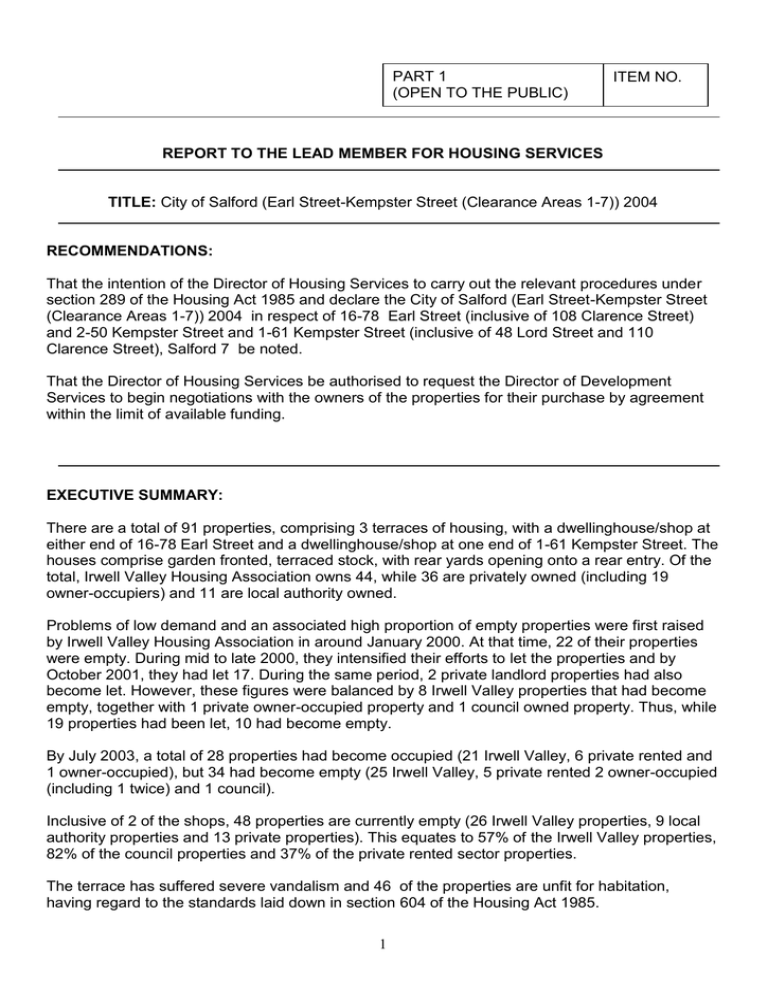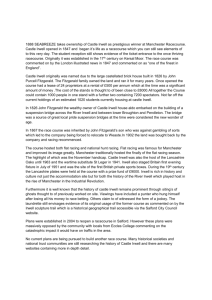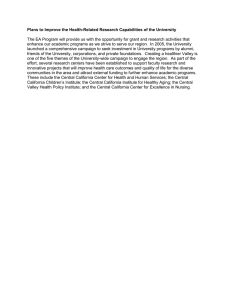PART 1 ITEM NO. (OPEN TO THE PUBLIC)
advertisement

PART 1 (OPEN TO THE PUBLIC) ITEM NO. REPORT TO THE LEAD MEMBER FOR HOUSING SERVICES TITLE: City of Salford (Earl Street-Kempster Street (Clearance Areas 1-7)) 2004 RECOMMENDATIONS: That the intention of the Director of Housing Services to carry out the relevant procedures under section 289 of the Housing Act 1985 and declare the City of Salford (Earl Street-Kempster Street (Clearance Areas 1-7)) 2004 in respect of 16-78 Earl Street (inclusive of 108 Clarence Street) and 2-50 Kempster Street and 1-61 Kempster Street (inclusive of 48 Lord Street and 110 Clarence Street), Salford 7 be noted. That the Director of Housing Services be authorised to request the Director of Development Services to begin negotiations with the owners of the properties for their purchase by agreement within the limit of available funding. EXECUTIVE SUMMARY: There are a total of 91 properties, comprising 3 terraces of housing, with a dwellinghouse/shop at either end of 16-78 Earl Street and a dwellinghouse/shop at one end of 1-61 Kempster Street. The houses comprise garden fronted, terraced stock, with rear yards opening onto a rear entry. Of the total, Irwell Valley Housing Association owns 44, while 36 are privately owned (including 19 owner-occupiers) and 11 are local authority owned. Problems of low demand and an associated high proportion of empty properties were first raised by Irwell Valley Housing Association in around January 2000. At that time, 22 of their properties were empty. During mid to late 2000, they intensified their efforts to let the properties and by October 2001, they had let 17. During the same period, 2 private landlord properties had also become let. However, these figures were balanced by 8 Irwell Valley properties that had become empty, together with 1 private owner-occupied property and 1 council owned property. Thus, while 19 properties had been let, 10 had become empty. By July 2003, a total of 28 properties had become occupied (21 Irwell Valley, 6 private rented and 1 owner-occupied), but 34 had become empty (25 Irwell Valley, 5 private rented 2 owner-occupied (including 1 twice) and 1 council). Inclusive of 2 of the shops, 48 properties are currently empty (26 Irwell Valley properties, 9 local authority properties and 13 private properties). This equates to 57% of the Irwell Valley properties, 82% of the council properties and 37% of the private rented sector properties. The terrace has suffered severe vandalism and 46 of the properties are unfit for habitation, having regard to the standards laid down in section 604 of the Housing Act 1985. 1 Neither the local authority nor Irwell Valley Housing Association consider that the properties have a sustainable future and neither are willing to risk the substantial investment that would be required to retain them. The City Council has consulted extensively with property owners and residents. The response has overwhelmingly supported or accepted clearance. BACKGROUND DOCUMENTS: None ASSESSMENT OF RISK: In the event that it is not possible to acquire all of the properties by agreement, it will be necessary to make a Compulsory Purchase Order. This would be the subject of a further report. If objections were received to the making of the Order and could not otherwise be resolved, then the Secretary of State would hold a Public Inquiry which might exclude properties from the Order. This would clearly have implications for the eventual redevelopment of the site, but would not be prohibitive. THE SOURCE OF FUNDING IS: Private Sector Housing Capital Programme LEGAL ADVICE OBTAINED: If approval is given, Corporate Services will be involved at all stages of the CPO process to secure compliance with relevant statutory requirements. FINANCIAL ADVICE OBTAINED: The Director of Development Services has estimated the acquisition cost of the properties to be £1,722,000 and the demolition cost to be £123,000. Additionally, there will be homeloss and disturbance compensation. Tenants are entitled to Homeloss compensation of £3100, while owner-occupiers are entitled to 10% of the value of their homes, subject to a minimum of £3100. Disturbance compensation is negotiable to cover the reasonable cost of moving house. Provision exists in the programme for the current financial year to facilitate initial acquisitions by agreement. The full cost of acquisition and clearance has been built into financial plans prepared under the Housing Market Renewal Fund, covering the period to the end of 2005/06. Following discussion with the Lead Officer for Private Sector Housing, it is considered that there is not currently a case for the payment of relocation grants. However, the position will be reviewed in 2 the light of further responses from owner-occupiers and will be the subject of a later report if appropriate. Ultimately, the site may be sold to a developer. In the short term, however, it would simply be landscaped, pending consideration of its future use in the context of proposals being developed following the Taylor Young Report commissioned by the Director of Development Services, which made a number of recommendations concerning the regeneration of the Lower Broughton area. Any additional costs incurred will be the subject of a further report. CONTACT OFFICER: A.P. Sinclair, Urban Regeneration Manager WARD(S) TO WHICH REPORT RELATES: Blackfriars KEY COUNCIL POLICIES: None DETAILS: A number of corporate initiatives were developed during the 1990s, in response to a social and economic decline affecting much of the Broughton area. One of these involved the appointment of a private sector partner during 1995, who began to construct new housing for sale on Lord Street, situated next to Earl and Kempster Streets. The partnership ultimately failed because the cost of development far exceeded the likely returns (values were declining) and the sale of private sector homes was too difficult to achieve. In the meantime, local authority owned houses on the adjacent Clarence Street, part of the Wheatersfield estate, have stood empty since they were renovated several years ago and, in fact, the whole estate has similarly been affected by problems of low demand. A decision has already been taken to clear the estate. The local authority’s Development Services directorate employed consultants, Taylor Young Urban Design, to identify opportunities to attract investment to Lower Broughton. Their report was produced during 2001. It proposed a number of projects, including residential development. However, it also indicated that private sector interest in the area is low and suggested that interest would initially focus on sites with a river frontage, where the Local Authority should consider a land acquisition strategy to provide development opportunities. It added that interest in areas such as Earl/Kempster should be viewed as a medium term aspiration over a period of perhaps 3-7 years, until confidence begins to spread throughout the area. This is reflected in the Area Development Framework, which states that unpopular stock will be cleared to assist the assembly of redevelopment sites on sufficient scale to be attractive to developers. Areas of private stock containing significant numbers of unfit and vacant stock will be cleared unless there is clear evidence that the area is sustainable. 3 It is clear that it may be years before the Earl/Kempster area is considered viable. However, even having regard to the longer-term plans for Lower Broughton, it is unrealistic to expect the properties to gradually recover through sporadic renovation A significant stimulus, such as group repair or renovation grant schemes, would be required to kick-start any recovery. At the same time, there is concern that, as the current owner-occupiers move on, their properties will experience poor market performance and settle at the lower end of the private rented sector, with the associated low level of investment. This has been a key issue in the social and economic decline of swathes of Broughton, necessitating other clearance programmes. It is difficult to envisage a circumstance that would lead to an influx of owner-occupancy. The owner-occupied sector is dominated by people who have lived there for a long time. Half have lived there for more than 16 years. Of the 12 conveyances between 1998 and April 2003, 10 were to private sector landlords. Having regard to these concerns about the sustainability of the area, including the failure of earlier investment, any investment would carry significant financial risk. The majority of the properties, even those that are fit for habitation, suffer from structural faults which would incur significant expense. It is anticipated that renovation of the streets would cost in the region of £1,586,751. Irwell Valley Housing Association has already indicated that it is unwilling to support any investment. For its part, the local authority does not have sufficient confidence to provide grant assistance. A more realistic alternative is presented by the opportunity to add the site to that of the Wheatersfield, with a view to a comprehensive remodelling of the area. The occupied properties are predominantly fit for habitation and are reasonably well maintained, but have structural defects. The empty properties are predominantly unfit through vandalism, including stripped roofs, stolen boilers or copper tanks and malicious damage including some arson. A consultation exercise indicated an overwhelming support for or acceptance of clearance. Of the 19 responses received from owner-occupiers, 17 indicated acceptance, with 9 of these indicating strong support or support. There was similar acceptance from 14 of the 18 tenants who responded, with 9 of these indicating strong support. Only 6 have indicated no support (4 tenants and 2 owner-occupiers). There was acceptance from 5 of the 6 landlords, excluding Irwell Valley, although only 1 of these actually indicated support. Inclusive of Irwell Valley, there is support or acceptance from the representatives of 80 of the 91 properties. Only 7 have indicated no support (4 tenants, 2 owner-occupiers and 1 landlord). The proposed Clearance Area would affect 45 properties judged to be fit under the standard laid down in the Act, comprising 21 Housing Association properties (16 of which are occupied), 17 owner-occupier properties (16 of which are occupied), 6 private landlord properties (all of which are occupied) and 1 council owned property (occupied). Having regard to the redevelopment issues mentioned above and the desire to provide attractive development opportunities in order to regenerate the Lower Broughton area, acquisition of these properties is necessary to secure a site of convenient shape and dimensions and to facilitate the satisfactory redevelopment of the site. None of the properties are listed and there is no listing pending. 4 Other than the single viable shop included in the proposed Clearance Area, there are no commercial undertakings known to be dependent upon these streets. A suitable compensation package will be negotiated with the proprietor of the shop. CONCLUSIONS: Very substantial investment would be required to bring these properties to a reasonable standard of repair. However, there is significant doubt that they would have a sustainable future even if renovated. The most satisfactory course of action is therefore considered to be clearance and the incorporation of the site into the redevelopment proposals for the broader Lower Broughton area. 5





